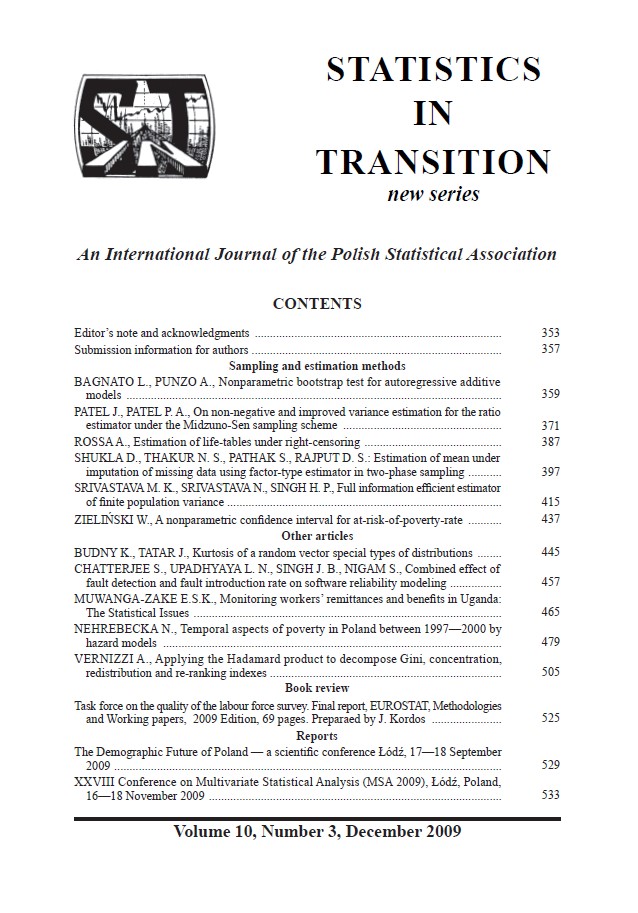ARTICLE
ABSTRACT
This paper examines the extent and characteristics of poverty in Poland analyzed on the basis of panel data from CHER (Consortium of Household Panels for European Socio-Economic Research) for the years 1997–2000. The analysis presented shows a low households’ dynamic of income in this period. The total number of years spent in poverty as well as different sequences of entry to and exit from poverty suggest the tendency to a persistent form of this phenomenon in the population. During the period studied, the basis for the calculation of the number of years spent in poverty was the rate of exit from and entry to poverty. The calculations have been made according to the method of analyzing poverty dynamics by hazard models, considering observed and unobserved heterogeneity of individuals to “explain” a chance of exit and return to the sphere of poverty.
KEYWORDS
Permanent and transient poverty, Hazard models, Multi-spell poverty episodes, Unobserved heterogeneity
REFERENCES
ALLISON, P. D. (1982), Discrete-time methods for the analysis of event histories, in Sociological Methodology 1982 (S. Leinhardt, ed.), Jossey-Bass Publishers, San Francisco 1982.
BANE, M., ELLWOOD, D. (1986), Slipping Into and Out of Poverty: The Dynamics of Spells, “Journal of Human Resources”, Vol. 21.
BARRO, R.. J. (1999), Inequality, growth and investment, Working Paper 7038, “National Bureau of Economic Research”.
BIEWEN, M. (2003), Who are the chronic poor? Evidence on the Extent and the Composition of Chronic Poverty in Germany, “IZA Discussion Paper”, No. 779.
CIURA, G. (2002), Poverty and impoverished area, The Bureau of Research, No. 884, (In Polish).
CAPPELLARI, L., JENKINS, S. (2002), Modeling low income transition, “Discussion Papers of DIW Berlin from DIW Berlin”, German Institute for Economic Research, No. 288.
CIECIELĄG, J., TOMASZEWSKI, A. (2003), Econometric analysis of panel data, (In Polish), Warsaw 2003.
DEVICIENTI, F. (2002), Poverty persistence in Britain: a multivariate analysis using the BHPS, 1991–1997, “Journal Of Economics”, No. 9.
DEVICIENTI, F. (2002), Estimating poverty persistence in Britain, “LABORatorio R. Revelli Working Papers Series”.
DOLTON, P., VAN DER KLAAUW, W. (1995), Leaving teaching in the UK: a duration analysis, “Economic Journal”, Vol. 105, No. 429.
DUNCAN, G. (1999), The PSID and Me, “IPR working papers”.
FRĄTCZAK, E., BABIKER, H., GACH-CIEPIELA, U. (2005), History occurances analysis – Elements, theory, chosen practical examples, (In Polish), Warsaw 2005.
Central Statistical Office, Existence situation of households in 2003, (In Polish),
www.stat.gov.pl/dane_spolgosp/warunki_zycia/syt_byt_gosp_2003/warunki_zycia03.doc
GOLINOWSKA, S. (1996), Polish poverty. Criteria. Assessment. Counteraction., The Institute of Labour and Social Studies, (In Polish), Warsaw 1996.
GOLINOWSKA, S. (1997), Polish poverty II. Criteria. Assessment. Counteraction., The Institute of Labour and Social Studies, (In Polish), Warsaw 1997.
HANSEN, J., WALHBERG, R. (2004), Poverty persistence in Sweden, „IZA Discussion Paper”, No. 1209.
JABŁOŃSKI, Ł. (2002), Economic growth or limiting income inequality in Poland?, No 4, (In Polish), Rzeszów 2002.
JARVIS, S., JENKINS, S. (1997), Low income dynamics in 1990s Britain, “Fiscal Studies” No. 18.
JENKINS, S. (1995), Easy estimation method for discrete-time duration models, “Oxford Bulletin of Economics and Statistics”, No. 57.
JENKINS, S. (1997), Estimation of discrete time proportional hazards models, “Stata Technical Bulletin Reprints”.
JENKINS, S. (2004), Survival Analysis, unpublished manuscript, Institute for Social and Economic.
KASPRZYK, B. (2000), Methodological aspects of assessing the level of wealth, Cracow University of Economics, (In Polish), Cracow 2000.
KIEFER, N. (1988), Economic Duration Data and Hazard Functions, “Journal Of Economic Literature”, Vol. XXVI.
KORDOS, J., OCHOCKI, A. (1993), Problems with measuring poverty in EWG countries and Poland, ” Statistical News”, (In Polish), Warsaw 1993.
KOT, S. M. (1995), Modelling level of wealth. Theory and application, Ossolineum, (In Polish), Wroclaw 1995.
KOT, S. M. (1998), The Cracow Poverty Line, Cracow University of Economics, (In Polish), Cracow 1998.
KUMOR, P., SZTAUDYNGER, J. (2007), Optimal compensation differentiation in Poland – econometric analysis, „Economist”, No. 1, (In Polish), Warsaw 2007.
KUROWSKI, P. (2007), Study of the modified minimum existance level in 2006, The Institute of Labour and Social Studies, (In Polish), http://www.solidar.uni.lodz.pl/min.egzystencji.pdf.
KUROWSKI, P. (2008), Study of the level and structure of the modified minimimum existance level in 2007, The Institute of Labour and Social Studies, (In Polish), http://www.ipiss.com.pl/Wo-2007.pdf.
LILLARD, L. A., WILLIS, R. J. (1978), Dynamics aspects of earning mobility, “Econometrica”, Vol. 46.
MEYER, B. D. (1990), Unemployment insurance and unemployment spell, “Econometrica”, Vol. 58.
OKRASA, W. (1999), Who Avoids and Who Escapes from Poverty during the Transition? Evidence from Polish Panel Data, 1993–96, The World Bank, Policy Research Working Paper 2218, Washington.
PANEK, T., PODGÓRSKI, J., SZULC, A. (1999), Poverty: theory and practical assessment, Warsaw School of Economics, (In Polish), Warsaw 1999.
PANEK, T. (2007) Poverty and inequality, Social Statistics, Polish Economics Publishers, (In Polish), Warsaw 2007.
PRENTICE, R., GLOECKER, L. (1978), Regression analysis of grouped survival data with application to breast cancer data, “Biometrics”, Vol. 34.
„Vovoidship annual statistical yearbook”, Central Statistical Office, (In Polish), Warsaw, 1998, 1999, 2000, 2001.
RADZIUKIEWICZ, M. (2007), Poverty reach in Poland, (In Polish), Polish Economics Publishers 2007.
RUSNAK, Z., KOŚNY, M. (2004), Impact of changes in equivalence scales on the income and equivalent expense distributions, in: Applications of Statistics and Mathematics in Economics, Stasiewicz, W. (Eds.), Wrocław University of Economics, (In Polish) ,Wroclaw 2004.
SHORROCKS, A. K. (1978), The Measurement of Mobility. „Econometrica”, Vol. 46, No. 5, p. 1013-1024.
STANISZ, A. (2003) Practical medicine 2002/03, Practical medicine, (In Polish).
STEVENS, A. (1999), Climbing out of poverty, falling back in. Measuring the persistence of poverty over multiple spells, “Journal of Human Resources”, Vol. 34, No. 3.
